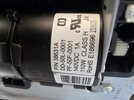I would buy an old Sony 100W/channel receiver and when you open it up, it will have a +52v DC and -52V DC rail. Tap into those to get your 102VDC.
Your door opener will only need the 140v max when lifting the heaviest loads (or drying to overcome a wet or icy seal of the rubber gasket on the bottom of the door).
In any case, I doubt your room slide requires the max load.
If you dint want to go that route, you can just get a 120v (primary) to 90vAC (secondary) transformer rated at 100 to 200VA. Connect the primary to your AC cord and the secondary to a bridge rectifier. The output will be a pulsing DC but not a huge deal. You can add a fat capacitor to the system if you want but not completely necessary.
To not answer your question, why can't you use the DC supply inside the door opener or even the door opener virtually as it is and the push button to activate it?



